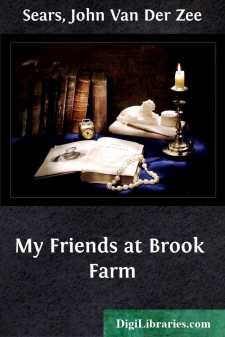Categories
- Antiques & Collectibles 13
- Architecture 36
- Art 48
- Bibles 22
- Biography & Autobiography 813
- Body, Mind & Spirit 142
- Business & Economics 28
- Children's Books 15
- Children's Fiction 12
- Computers 4
- Cooking 94
- Crafts & Hobbies 4
- Drama 346
- Education 46
- Family & Relationships 57
- Fiction 11828
- Games 19
- Gardening 17
- Health & Fitness 34
- History 1377
- House & Home 1
- Humor 147
- Juvenile Fiction 1873
- Juvenile Nonfiction 202
- Language Arts & Disciplines 88
- Law 16
- Literary Collections 686
- Literary Criticism 179
- Mathematics 13
- Medical 41
- Music 40
- Nature 179
- Non-Classifiable 1768
- Performing Arts 7
- Periodicals 1453
- Philosophy 64
- Photography 2
- Poetry 896
- Political Science 203
- Psychology 42
- Reference 154
- Religion 513
- Science 126
- Self-Help 84
- Social Science 81
- Sports & Recreation 34
- Study Aids 3
- Technology & Engineering 59
- Transportation 23
- Travel 463
- True Crime 29
My Friends at Brook Farm
Description:
Excerpt
CHAPTER I
THE OLD COLONIE
In May, 1624, the Dutch packet New Netherlands sailed up the Hudson River to the head of navigation, bringing a company of eighteen families under the leadership of Adrian Joris. The immigrants landed at a little trading post called Beaverwick kept by one Tice Oesterhout, a pioneer hunter, married to a Mohawk Squaw. In a few days a party of Indians, probably Mohawks, waited on the newcomers and politely made inquiry as to their object in entering upon Indian lands without notice or permission; Tice Oesterhout and his wife acting as interpreters. Joris replied that they came in peace and hoped to abide in peace on friendly terms with the Indians. He was told that he and his people would be welcome if they joined the universal peace union of the Iroquois, and not otherwise. This proposition the settlers agreed to by acclamation. In due course the General Council of the Five Nations accepted the Colony as a member of the Iroquois Federation. Joris was recognized as the Civil Chief of the little community, and, as he was a Walloon, his people became the Walloon Nation of the Great Peace Alliance. The Great Peace was the treaty forming the basis of the Iroquois Federation. The Colonists, instead of making a treaty with the Indians, gave their adhesion to one already made, thereby securing safety and a practical monopoly of the fur trade on the upper Hudson. They sent annual presents to the Iroquois General Council, which were doubtless received as tribute in recognition of sovereignty, but the Walloon Nation did not seem to care very much about the sovereignty business so long as the fur business continued to prosper, as it did for the next half century.
Two score or so of Walloons did not constitute a very formidable nation but the men were reinforced by the women who had an equal voice not only in local affairs but in the General Council of the Federation.
The settlers built their houses on the Indian trail leading Westward to which they gave the name of Beaver street—their grand boulevard which must have been two or three squares long. Beaver Street was the main highway of the Walloon Nation and was the center of the "Old Colonie" as the Dutch neighborhood was subsequently called. Under English rule, the "Old Colonie" or Beaverwick was merged with Fort Orange and Rensselaerwick, these, collectively, being named Albany in honor of the Duke of York, Albany being one of his titles.
The Dutch of the "Old Colonie" did not take kindly to the supremacy of the English. They obeyed the laws and the constituted authorities but they stubbornly maintained their autonomy as far as practicable, holding aloof from their English neighbors, keeping to their own language, their own manners and customs, and their own habits of life, generation after generation. As the "Old Colonie" extended its borders and new elements were added to its population, these Dutch characteristics were gradually modified and finally disappeared altogether, but they resisted modern influences many years and as late as the middle of the nineteenth century, evidences of Dutch ancestry were still to be noticed among the people of the "Old Colonie."
My father's house, where I was born, stood on the south side of Beaver street next to that of the Ostranders where the last Walloon Civil Chief was said to have lived....


